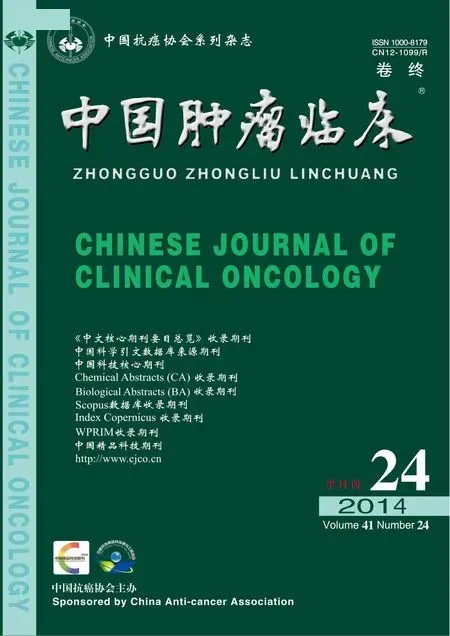恶性间叶肿瘤的间叶-上皮表型转化研究进展*
杨吉龙 杜晓玲 王国文 杨 蕴
恶性间叶肿瘤的间叶-上皮表型转化研究进展*
杨吉龙①杜晓玲②王国文①杨 蕴①
相对于上皮性肿瘤的上皮-间叶表型转化(epithelial to mesenchymal transition,EMT)及间叶-上皮表型转化(mesenchymal to epithelial transition,MET)的研究,恶性间叶性肿瘤中MET相关研究较少。MET在分子水平上反映为上皮性标志物如E-钙粘素E-cadherin的上调和间叶性标志物如波形蛋白Vimentin的下调,其过程涉及始动信号、转录因子调节、表面标志物的改变、信号通路改变等多个环节。本文概述了恶性间叶肿瘤中与MET紧密相关的TGF-β等始动因素、SNAI等关键转录因子、miRNA调节因素对重要细胞信号通路等影响及MET对肿瘤的演进及转归的影响等方面的研究,为针对MET的临床应用奠定基础。
肉瘤 间叶-上皮表型转化 E-钙粘素 靶向治疗
细胞的上皮-间叶表型转化(epithelial to mesenchymal transition,EMT)和间叶-上皮表型转化(mesenchymal to epithelial transition,MET)在胚胎发育和器官形成方面发挥重要作用[1]。越来越多的证据表明MET在恶性肿瘤的演进中具有关键作用[2-4]。在上皮性肿瘤中EMT的上皮细胞丧失细胞之间的粘附分子,细胞表型发生了转换、极性改变、细胞骨架重塑,在乳腺癌等恶性肿瘤的侵袭转移中起关键作用且与肿瘤的预后不良相关[5-7]。肉瘤中MET研究较少,MET的临床意义及其相关分子机制如始动因素、转录因子、调节因素、对细胞形态及功能的影响、对重要细胞信号通路的影响等问题尚需系统且深入的探讨。同时,MET的启动、发生、后续反应是一个复杂的通路,其中有多个位点、步骤、分子可能是潜在的治疗靶点或有用的生物标记物。因此,对MET的深入了解有助于明确肉瘤的发病及演进机制,并有助于发现或筛选新的预防方法及特异性治疗靶点。
1 MET
越来越多的证据表明与EMT相反的MET过程在恶性肿瘤的演进中起关键作用[2-4]。在恶性肿瘤中,可能存在两种类型的MET且与肿瘤的演进相关:一种MET是癌细胞转移过程中在远隔部位形成转移病灶时发生的表型转变,另一种是肉瘤中间叶源性细胞向上皮性细胞的分化或者获得上皮样表型[8]。在第一种类型的MET中,MET促进了癌细胞在远处转移部位形成与原发病相似肿瘤的过程。在这个过程中,具有间叶表型特征的转移性癌细胞克服了局部组织的多重障碍而重新获得上皮样表型[1,9]。有研究显示在乳腺癌及膀胱癌等病变中,对比原发灶和转移灶发现上皮标志物钙黏着蛋白E-cadherin表达先缺失继而上调,即EMT和MET过程的转换[10-12]。
相对于上皮性肿瘤中MET的研究,第二种类型的MET即间叶肿瘤细胞出现上皮样表型的报道较少。Yang等[13]在体外实验发现软骨肉瘤细胞系SW1353呈现出类似上皮组织的极性改变,表达E-cadherin、上皮桥粒斑蛋白和胞质紧密粘连蛋白ZO-1,这种改变与SW细胞系的c-Met原癌基因有关。在滑膜肉瘤中SYT-SSX1融合蛋白通过SNAI1和Slug(SNAI2)的调节可诱导MET[14]。平滑肌肉瘤中抑制Slug表达也可引起E-cadherin表达的显著增加,同时细胞形态向圆形变化,细胞增殖、侵袭及迁移能力减弱,即发生MET[15]。Saulnier等[16]用体外实验也证实脂肪间叶细胞经MET可分化为肝细胞样细胞,形态和功能上类似肝细胞及间叶细胞表型,N-cadherin和Vimentin降低,E-cadherin表达升高,并认为和SNAI1和TWIST下调密切相关。
2 MET的分子标记
MET时细胞丧失运动性并重获细胞之间的密切联系,在分子水平上反映为上皮标志物的上调和间叶标志物的下调。典型的上皮细胞标志物如E-钙粘蛋白、广谱角蛋白Pan-CK、EMA、β-钙粘蛋白、CD44和CD34等,间叶标志物包括波形蛋白Vimentin和神经钙黏着蛋白N-cadherin、α-平滑肌肌动蛋白(α-SMA),结蛋白Desmin,MSA和其他特殊标记物如NSE,FN和SYN等。MET中最重要的标志物是E-cadherin,它是界定上皮细胞的标志之一,其编码基因CDH1被公认为癌浸润转移抑制基因[17]。EMT时,E-cadherin表达下调,细胞连接及骨架改变引发细胞极性改变,进而促进癌细胞的浸润和转移[18]。E-cadherin表达下调可以视为EMT的原因和结果,也是EMT的分子标志。同样的,在转移灶中癌细胞再次表达E-cadherin是癌MET的重要标志[2]。N-钙粘蛋白是一种跨膜糖蛋白,其表达导致E-钙粘蛋白的表达下调从而增加癌细胞的运动以及迁移。波形蛋白Vimentin是一种通常表达在间充质来源的细胞Ⅲ型中间纤维,有报道显示其表达涉及胚胎发育及伤口愈合及肿瘤的侵袭。因此,N-钙粘蛋白和波形蛋白被认为是典型的间叶表型标志物[4]。需要强调的是,尽管肉瘤中有MET过程发生,间叶性肿瘤细胞获得E-钙粘蛋白和β-钙粘蛋白等上皮样表型标记的增加,但在多数肉瘤细胞中典型的间叶标志物如Vimentin等仍然占主导地位。
3 肉瘤中MET发生过程及其机制
作为EMT和MET的关键指标之一,E-cadherin的在肿瘤的进展中起关键作用,其功能丧失会增加肿瘤的侵袭性[2,4,14,19-21]。有文献显示TGF-β、AKT等信号通路异常、融合基因表达产物如SYT-SXX、小RNA如miR-30的调节等因素对MET有调节或者启动作用[14,22-24]。在MET中,与E-cadherin转录有关的因素如若干锌指同系物家族(SNAI1和Slug)、碱性螺旋-环-螺旋家族(E47和TWIST)、ZEB家族(ZEB1、ZEB2)等被认为是调节MET的关键分子[15]。转录因子SNAI、ZEB、E47及KLF8直接抑制E-Cadherin的转录,如SNAI1和Slug可与E-cad启动子的E-box基序结合直接抑制E-cadherin的转录[25],而TWIST、Goosecoid、E2.2及FOXC2则间接抑制E-cadherin的转录[1]。滑膜肉瘤中融合蛋白SYT-SSX1和SYT-SSX2可以克服SNAI1/Slug介导的E-cadherin转录抑制,从而促进E-cadherin的表达而出现上皮样分化[14,20]。因此,MET的机制可能是上行信号如TGF-β、SYT-SSX等因素诱导或者调节与E-钙粘蛋白转录紧密相关的转录因子,增加E-钙粘蛋白的表达,从而诱导细胞出现上皮样表型。
4 肉瘤中MET的始动信号
肉瘤中MET发生的始动信号包括由生长因子受体如血小板衍生生长因子受体(PDGFR)、成纤维细胞生长因子受体(FGFR)、c-Met、转化生长因子β-1(TGF-β1)、胰岛素相关的生长因子1受体(IGF1R)等介导的生长信号等[3,6,26-28]。除了这些,MET的过程中其他几个启动信号已被证明如SYT-SSX融合蛋白、肾母细胞瘤蛋白WT1、骨形态发生蛋白7(BMP7)、WNT4、细胞骨架蛋白formin IV154-157、自分泌运动因子/磷酸葡萄糖异构酶(autocrine motility factor/ phosphoglucose isomerase,AMF/PGI)和Wnt受体低密度脂蛋白受体相关蛋白5(LRP5)等。
在滑膜肉瘤中融合蛋白SYT-SSX1和SYT-SSX2克服了SNAI1/Slug介导的E-cadherin转录抑制,从而诱导间叶细胞的上皮表型分化[14]。肾个体的发育是个很好描述MET的过程,这个过程中肾母细胞瘤蛋白WT1、骨形态发生蛋白7(BMP7)、WNT4和细胞骨架蛋白formin IV154-157等几个基因是诱导MET的重要因素[1,29]。作为参与葡萄糖代谢一种多功能酶,AMF/PGI的沉默可导致人肺纤维肉瘤细胞出现MET且恶性度降低,抑制了AMF/PG的人骨肉瘤细胞系MG-63和小鼠骨肉瘤细胞系LM8出现上皮样表型且有生长、运动和侵袭能力的下降[30]。LRP5在骨肉瘤中高表达且与相对较低的转移率和无病生存率相关[27]。可溶性LRP5(sLRP5)的转染导致Saos-2骨肉瘤细胞中E-钙粘蛋白显著上调和N-钙粘蛋白下调,且与SNAI1/Slug下调有关,增加的E-cadherin主要出现在细胞间接触的边界,与E-cadherin介导的抑制肿瘤侵袭和转移相关联[27]。
5 MET相关的转录因子
在EMT及MET过程中的关键分子包括生长因子如(TGF-β,Wnts)、转录因子(SNAIs,LEF,nuclear β-catenin)、细胞-细胞间的分子粘合分子(钙黏着蛋白cadherins,连环蛋白catenins)和细胞-细胞外粘附基质(ECM)的粘附分子(整合素integrins,焦接触蛋白focal contact proteins,细胞外基质蛋白)、细胞骨架调节剂(Rho家族)和胞外蛋白酶(基质金属蛋白酶MMPs,纤维蛋白溶酶原活化剂PIAs)等[1-4,6,9,21,26-28]。这些分子里,转录因子的作用最强烈和直接[3,7,9,14,19,23,31-32]。MET主要涉及的转录因子包括SNAI1、Slug、E47、TWIST、ZEB1及ZEB2等。在上皮性恶性肿瘤的进展中,E-Cadherin不同于其他的抑癌基因,其缺失与再表达不是取决于不可逆转的基因缺失或者突变,调节其表达的机制是可逆的[33]。转录因子SNAIs、ZEB、E47及KLF8直接抑制E-Cadherin的转录,而Twist、Goosecoid、E2.2及Foxc2间接抑制E-Cadherin转录[1]。其中SNAI1和Slug可与E-cad启动子E-box基序结合直接抑制E-cad转录,活化的Akt通过GSK-3β磷酸化稳定核β-catenin,后者作为中介也可激活Slug,从而抑制E-cad表达。反之,则诱导MET发生[25]。SIP1也是针对E2盒上的E-Cadherin的启动子的一种锌指转录因子,这些转录因子参与上皮或间充质细胞分化过程[4,21,31]。
6 MET相关miRNA
虽然已经明确miR-200家族可以调节EMT,其他miRNA也参与了ETM及MET的调节[34]。如miR-138通过直接作用于波形蛋白mRNA、直接作用于ZEB和作为EZH2的表观遗传调节因子这三种不同的途径调节EMT[35]。一些miRNA能够直接调节E-cadherin的表达而调节MET,一些miRNA可以通过调节转录因子及MET相关信号通路进而调节E-cadherin的表达[36]。miRNA的些调节过程中有的需要初始或上游信号,而有的是独立于上游信号。最重要的是miRNA的这些调节功能在肿瘤的进展过程中非常重要,因而可以作为潜在的治疗靶点。
与MET相关的miRNA包括miR-302-367、miR-30、miR-9、miR-23b、miR-29c、miR-194及miR-101[8]。miRNA簇302-367作用于TGF-β受体2,促进E-Cadherin的表达,诱导多能干细胞的产生效率并促进间充质细胞到上皮细胞变化必要的集落形成[37]。miR-30通过直接靶向作用于SNAI1 mRNA的3'-UTR进而负性调节SNAI1的表达[38]。在黑色素瘤中miRNA-9通过抑制NF-κB1-SNAI1途径上调E-Cadherin蛋白并诱导MET。miR-23bmiR-29cmiR-194通过恢复E-Cadherin和减少波形蛋白Vimentin表达而诱导MET[39]。miR-101导致内源性EZH2的降解和并恢复E-钙粘蛋白的细胞膜定位[40]。
7 具有上皮样表型改变的肉瘤
目前已经在滑膜肉瘤、平滑肌肉瘤等多个软组织肉瘤中有报道显示上皮细胞样分化或者上皮样表型的出现,且在这些肿瘤的进展和预后中有重要作用[4]。如在滑膜肉瘤中E-cadherin和β-catenin的表达降低和核β-连环蛋白的异常表达是滑膜肉瘤不良预后因素,同样在中国滑膜肉瘤样本中E-cadherin和β-catenin的表达与其上皮分化相关,E-钙粘蛋白和β-catenin的表达减少提示其有潜在的高复发或转移风险且预后较差。在人平滑肌肉瘤细胞系SK-LMS-1中抑制Slug表达可引起E-cadherin表达显著增加,同时细胞形态向圆形变化,细胞增殖、侵袭及迁移能力减弱,即发生MET[15]。在人平滑肌肉瘤组织中,检测到E-钙粘蛋白、EMA及CK等上皮样标记的表达,且与平滑肌肉瘤患者较长的生存期显著相关[4]。上皮样肉瘤为来源组织不明的罕见间叶肿瘤,肿瘤细胞显示主要是上皮分化的多向分化,表型为上皮和间叶标记物的表达如细胞角蛋白,EMA,波形蛋白和CD34[41]。大多数上皮样肉瘤强烈表达钙粘素,这可能有助于形成他们的上皮样外观,但是由于缺乏E-钙粘蛋白表达,这些肿瘤仅显示了不完整的上皮细胞分化[42]。透明细胞肉瘤有时可能因显示上皮样外观而被误诊为其他软组织肿瘤如上皮样平滑肌肉瘤及上皮样肉瘤等[60],但其细胞角蛋白、EMA、结蛋白、肌特异性肌动蛋白(MSA)等标记是缺失的。透明细胞肉瘤和恶性黑色素瘤依靠免疫组化染色是很难区分的,这在一定程度上提示他们可能共享了上皮细胞的分化模式[43]。
在常见原发性骨恶性肿瘤如Ewing肉瘤/原始神经外胚层肿瘤(ES/PNET)、骨肉瘤、脊索瘤等病变中有报道显示上皮样表型改变。ES/PNET因经常表达细胞角蛋白CK而提示其有上皮细胞分化[44]。Schuetz等[44]研究了30例ES/PNETs结果发现,尽管E-钙粘蛋白为阴性,但紧密连接的标记物如claudin-1、ZO-1和occludin等高表达,提示在ES/PNET中形成紧密连接,从而提示ES/PNET局部发生了上皮细胞分化。在骨肉瘤中上皮钙粘蛋白标记物-11(CDH11)的表达及AMF/PGI干扰实验的结果提示MET的存在,且与患者的存活显著相关[45]。Niinaka等[30]报道了人类和小鼠的骨肉瘤细胞系中AMF/PGI的沉默诱导MET的发生,主要体现在E-钙粘蛋白和细胞角蛋白表达上调和Vimentin的下调。脊索瘤是一种比较少见的骨肿瘤,据报道脊索瘤频繁表达多种粘附分子和上皮细胞标记物如角蛋白、EMA、血管细胞粘附分子VCAM、CD44、N-钙粘蛋白和E-钙粘蛋白等,提示肿瘤细胞可能通过上皮分化特征性的细胞-细胞相互作用机制而生长[46-48]。此外,Saad和Collins表明脊索瘤的E-cadherin的表达与肿瘤复发、无病生存期和生存率显著相关,可以预测儿童的脊索瘤的预后[49]。Triana等[50]报道在脊索瘤中降低E-Cadherin表达及提高N-Cadherin的表达可能会将其从侵袭性较低的肿瘤转变为侵袭性更强的肿瘤表型。
8 肉瘤MET的临床应用
在上皮性肿瘤中,MET多发在转移灶的形成过程中且有重要的生物学意义,诱导MET即逆转EMT对治疗有显著的影响。如临床试验中高表达E-Cadherin的非小细胞肺癌患者接受埃罗替尼靶向药物治疗效果比较好[1];组蛋白脱乙酰基酶抑制剂vorinostat通过诱导头颈癌细胞系KB和Hep-2发生MET,可增加靶向药物吉非替尼的治疗作用等[51]。乳腺癌MDA-MB-231细胞系、前列腺DU-145细胞系和肝细胞共同培养时细胞形态发生上皮样改变及表达E-cadherin和E-cadherin蛋白阴性表达的细胞相比化疗抗性明显增高且有预后价值[52]。尽管Kase等[25]检测331例Ⅰ~Ⅲ期肺癌患者的E-Cadherin和β-catenin表达发现E-Cadherin无独立预后价值,但是β-catenin表达减少且和预后有显著关系。Soltermann等[53]利用免疫组织化学观察533例非小细胞肺癌MET改变,单变量分析显示间叶标记骨膜蛋白periostin的表达和PFS下降显著相关。
在间叶源性肿瘤中,MET临床意义尚探讨不多但已经显示出其在靶向治疗中的重要作用。Saulnier等[16]体外实验证实脂肪间叶细胞经MET可分化为肝细胞样细胞,而且具有成熟肝细胞一些特征,如富含环氧化物酶EPHX1和前列腺素受体PGER4,可以发挥药物代谢功能,对于临床有潜在意义。某些临床证明发生MET的肉瘤患者,高表达E-cadherin较表达缺失者对于化疗药物更加敏感[1]。Slug等[4]发现转录因子是肉瘤MET过程中的重要调节因子,也是潜在的治疗靶标,如神经母细胞瘤中下调Slug可增加伊马替尼、依托泊苷、阿霉素等药物诱导凋亡的灵敏度。此外,在放疗治疗中Slug缺失的细胞对放射所致的DNA损伤很敏感。所以,抑制Slug和其他转录因子,诱导MET可能会提高肿瘤对放化疗的敏感性。
9 结论
间叶恶性肿瘤中MET在分子水平上反映为上皮性标志物如E-钙粘素(E-cadherin)的上调和间叶性标志物如波形蛋白(Vimentin)的下调,其过程涉及始动信号、转录因子调节、表面标记的改变、miRNA的调节、信号通路改变等多个环节,并对肿瘤的演进及转归有非常重要的作用。明确MET相关机制并针对这一复杂过程中的特定环节进行干预,可能有一定的临床应用前景。
1 Thiery JP,Acloque H,Huang RY,et al.Epithelial-mesenchymal transitions in development and disease[J].Cell,2009,139:871-890.
2 Wells A,Yates C,Shepard CR.E-cadherin as an indicator of mesenchymal to epithelial reverting transitions during the metastatic seeding of disseminated carcinomas[J].Clin Exp Metastasis,2008, 25(6):621-628.
3 Hong KO,Kim JH,Hong JS,et al.Inhibition of Akt activity induces the mesenchymal-to-epithelial reverting transition with restoring E-cadherin expression in KB and KOSCC-25B oral squamous cell carcinoma cells[J].J Exp Clin Cancer Res,2009,28:28.
4 Yang J,Eddy JA,Pan Y,et al.Integrated proteomics and genomics analysis reveals a novel mesenchymal to epithelial reverting transition in leiomyosarcoma through regulation of slug[J].Mol Cell Proteomics,2010,9(11):2405-2413.
5 Devarajan E,Song YH,Krishnappa S,et al.Epithelial-mesenchymal transition in breast cancer lines is mediated through PDGF-D released by tissue-resident stem cells[J].Int J Cancer 2012,131(5):1023-1031.
6 Kalluri R,Weinberg RA.The basics of epithelial-mesenchymal transition[J].J Clin Invest,2009,119(6):1420-1428.
7 Mani SA,Yang J,Brooks M,et al.Mesenchyme Forkhead 1 (FOXC2)plays a key role in metastasis and is associated with aggressive basal-like breast cancers[J].Proc Natl Acad Sci U S A, 2007,104(24):10069-10074.
8 Yang J,Du X,Wang G,et al.Mesenchymal to epithelial transition in sarcomas[J].Eur J Cancer,2014,50(3):593-601.
9 Elloul S,Vaksman O,Stavnes HT,et al.Mesenchymal-to-epithelial transition determinants as characteristics of ovarian carcinoma effusions[J].Clin Exp Metastasis,2010,27(3):161-172.
10 Chao YL,Shepard CR,Wells A.Breast carcinoma cells re-express E-cadherin during mesenchymal to epithelial reverting transition [J].Mol Cancer,2010,9:179.
11 Aokage K,Ishii G,Ohtaki Y,et al.Dynamic molecular changes associated with epithelial-mesenchymal transition and subsequent mesenchymal-epithelial transition in the early phase of metastatic tumor formation[J].Int J Cancer,2011,128(7):1585-1595.
12 Chaffer CL,Brennan JP,Slavin JL,et al.Mesenchymal-to-epithelial transition facilitates bladder cancer metastasis:role of fibroblast growth factor receptor-2[J].Cancer Res,2006,66(23):11271-11278.
13 Fitzgerald MP,Gourronc F,Teoh ML,et al.Human Chondrosarcoma Cells Acquire an Epithelial-Like Gene Expression Pattern via an Epigenetic Switch:Evidence for Mesenchymal-Epithelial Transition during Sarcomagenesis[J].Sarcoma 2011,2011:598218.
14 Saito T,Nagai M,Ladanyi M.SYT-SSX1 and SYT-SSX2 interfere with repression of E-cadherin by snail and slug:a potential mecha-nism for aberrant mesenchymal to epithelial transition in human synovial sarcoma[J].Cancer Res,2006,66(14):6919-6927.
15 Yang J,Eddy JA,Pan Y,et al.Integrated proteomics and genomics analysis reveals a novel mesenchymal to epithelial reverting transition in leiomyosarcoma through regulation of slug[J].Mol Cell Proteomics,2010,9(11):2405-2413.
16 Saulnier N,Piscaglia AC,Puglisi MA,et al.Molecular mechanisms underlying human adipose tissue-derived stromal cells differentiation into a hepatocyte-like phenotype[J].Dig Liver Dis,2010,42 (12):895-901.
17 Voulgari A,Pintzas A.Epithelial-mesenchymal transition in cancer metastasis:mechanisms,markers and strategies to overcome drug resistance in the clinic[J].Biochim Biophys Acta 2009,1796(2):75-90.
18 Li B,Zheng YW,Sano Y,et al.Evidence for mesenchymal-epithelial transition associated with mouse hepatic stem cell differentiation [J].PLoS One,2011,6(2):e17092.
19 Saito T,Oda Y,Sugimachi K,et al.E-cadherin gene mutations frequently occur in synovial sarcoma as a determinant of histological features[J].Am J Pathol,2001,159(6):2117-2124.
20 Sato H,Hasegawa T,Abe Y,et al.Expression of E-cadherin in bone and soft tissue sarcomas:a possible role in epithelial differentiation[J].Hum Pathol,1999,30(11):1344-1349.
21 Zeisberg M,Neilson EG.Biomarkers for epithelial-mesenchymal transitions[J].J Clin Invest,2009,119(6):1429-1437.
22 Xu J,Lamouille S,Derynck R.TGF-beta-induced epithelial to mesenchymal transition[J].Cell Res,2009,19(2):156-172.
23 Saito T,Oda Y,Kawaguchi K,et al.E-cadherin mutation and Snail overexpression as alternative mechanisms of E-cadherin inactivation in synovial sarcoma[J].Oncogene,2004,23(53):8629-8638.
24 Danielson LS,Menendez S,Attolini CS,et al.A differentiation-based microRNA signature identifies leiomyosarcoma as a mesenchymal stem cell-related malignancy[J].Am J Pathol 2010, 177(2):908-917.
25 Bolos V,Peinado H,Perez-Moreno MA,et al.The transcription factor Slug represses E-cadherin expression and induces epithelial to mesenchymal transitions:a comparison with Snail and E47 repressors[J].J Cell Sci,2003,116(Pt3):499-511.
26 Javle MM,Gibbs JF,Iwata KK,et al.Epithelial-mesenchymal transition(EMT)and activated extracellular signal-regulated kinase (p-Erk)in surgically resected pancreatic cancer[J].Ann Surg Oncol,2007,14(12):3527-3533.
27 Guo Y,Zi X,Koontz Z,et al.Blocking Wnt/LRP5 signaling by a soluble receptor modulates the epithelial to mesenchymal transition and suppresses met and metalloproteinases in osteosarcoma Saos-2 cells[J].J Orthop Res,2007,25(7):964-971.
28 Zavadil J,Bottinger EP.TGF-beta and epithelial-to-mesenchymal transitions[J].Oncogene,2005,24(37):5764-5774.
29 Thiery JP.Epithelial-mesenchymal transitions in tumour progression[J].Nat Rev Cancer,2002,2(6):442-454.
30 Niinaka Y,Harada K,Fujimuro M,et al.Silencing of autocrine motility factor induces mesenchymal-to-epithelial transition and suppression of osteosarcoma pulmonary metastasis[J].Cancer Res, 2010(70):9483-9493.
31 Perez-Losada J,Sanchez-Martin M,Rodriguez-Garcia A,et al. Zinc-finger transcription factor Slug contributes to the function of the stem cell factor c-kit signaling pathway[J].Blood,2002,100(4):1274-1286.
32 Hajra KM,Chen DY,Fearon ER.The SLUG zinc-finger protein represses E-cadherin in breast cancer[J].Cancer Res,2002,62(6):1613-1618.
33 Tsuji T,Ibaragi S,Hu GF.Epithelial-mesenchymal transition and cell cooperativity in metastasis[J].Cancer Res,2009,69(18):7135-7139.
34 Xiong M,Jiang L,Zhou Y,et al.The miR-200 family regulates TGF-β1-induced renal tubular epithelial to mesenchymal transition through Smad pathway by targeting ZEB1 and ZEB2 expression[J].Am J Physiol Renal Physiol,2012,302(3):F369-379.
35 Liu X,Wang C,Chen Z,et al.MicroRNA-138 suppresses epithelial-mesenchymal transition in squamous cell carcinoma cell lines[J]. Biochem J,2011,440(1):23-31.
36 Liu S,Lu H,Liu A,et al.MicroRNA-9 up-regulates E-cadherin through inhibition of NF-κB1-Snail1 pathway in melanoma[J].J Pathol,2012,226(1):61-72.
37 Liao B,Bao X,Liu L,et al.MicroRNA cluster 302-367 enhances somatic cell reprogramming by accelerating a mesenchymal-to-epithelial transition[J].J Biol Chem,2011,286(19):17359-17364.
38 Kumarswamy R,Mudduluru G,Ceppi P,et al.MicroRNA-30a inhibits epithelial-to-mesenchymal transition by targeting Snai1 and is downregulated in non-small cell lung cancer[J].Int J Cancer, 2012,130(9):2044-2053.
39 Dong P,Kaneuchi M,Watari H,et al.MicroRNA-194 inhibits epithelial to mesenchymal transition of endometrial cancer cells by targeting oncogene BMI-1[J].Mol Cancer,2011,10:99.
40 Carvalho J,van Grieken NG,Pereira PM,et al.Lack of microRNA-101 causes E-cadherin functional deregulation through EZH2 upregulation in intestinal gastric cancer[J].J Pathol,2012,228(1):31-44.
41 Armah HB,Parwani AV.Epithelioid sarcoma[J].Arch Pathol Lab Med,2009,133(5):814-819.
42 Smith ME,Brown JI,Fisher C.Epithelioid sarcoma:presence of vascular-endothelial cadherin and lack of epithelial cadherin[J].Histopathology,1998,33(5):425-431.
43 Swanson PE,Wick MR.Clear cell sarcoma.An immunohistochemical analysis of six cases and comparison with other epithelioid neoplasms of soft tissue[J].Arch Pathol Lab Med,1989,113(1):55-60.
44 Schuetz AN,Rubin BP,Goldblum JR,et al.Intercellular junctions in Ewing sarcoma/primitive neuroectodermal tumor:additional evidence of epithelial differentiation[J].Mod Pathol 2005,18(11):1403-1410.
45 Nakajima G,Patino-Garcia A,Bruheim S,et al.CDH11 expression is associated with survival in patients with osteosarcoma[J].Cancer Genomics Proteomics,2008,5(1):37-42.
46 Mori K,Chano T,Kushima R,et al.Expression of E-cadherin in chordomas:diagnostic marker and possible role of tumor cell affinity[J].Virchows Arch,2002,440(2):123-127.
47 Naka T,Oda Y,Iwamoto Y,et al.Immunohistochemical analysis of E-cadherin,alpha-catenin,beta-catenin,gamma-catenin,and neural cell adhesion molecule(NCAM)in chordoma[J].J Clin Pathol,2001,54(12):945-950.
48 Horiguchi H,Sano T,Qian ZR,et al.Expression of cell adhesion molecules in chordomas:an immunohistochemical study of 16 cases [J].Acta Neuropathol,2004,107(2):91-96.
49 Saad AG,Collins MH.Prognostic value of MIB-1,E-cadherin, and CD44 in pediatric chordomas[J].Pediatr Dev Pathol,2005,8 (3):362-368.
50 Triana A,Sen C,Wolfe D,et al.Cadherins and catenins in clival chordomas:correlation of expression with tumor aggressiveness[J]. Am J Surg Pathol,2005,29(11):1422-1434.
51 Bruzzese F,Leone A,Rocco M,et al.HDAC inhibitor vorinostat enhances the antitumor effect of gefitinib in squamous cell carcinoma of head and neck by modulating ErbB receptor expression and reverting EMT[J].J Cell Physiol,2011,226(9):2378-2390.
52 Tang D,Xu S,Zhang Q,et al.The expression and clinical significance of the androgen receptor and E-cadherin in triple-negative breast cancer[J].Med Oncol,2012,29(2):526-533.
53 Soltermann A,Tischler V,Arbogast S,et al.Prognostic significance of epithelial-mesenchymal and mesenchymal-epithelial transition protein expression in non-small cell lung cancer[J].Clin Cancer Res,2008,14(22):7430-7437.
(2014-09-10收稿)
(2014-12-04修回)
(本文编辑:郑莉)
Mesenchymal to epithelial transition in malignant mesenchymal tumors
Jilong YANG1,Xiaoling DU2,Guowen WANG1,Yun YANG1
1Department of Bone and Soft Tissue Tumors,Tianjin Medical University Cancer Hospital and Institute,National Clinical Research Center of Cancer,Key Laboratory of Cancer Prevention and Therapy,Tianjin,Tianjin 300060,China;3Department of Diagnostics,Tianjin Medical University,Tianjin 300061,China
Jilong YANG;E-mail:yangjilong@tjmuch.com
Mesenchymal to epithelial transition(MET),whereby mesenchymal cells become more epithelial like in phenotype, was observed to occur during normal development and in cancers.Numerous investigations have been conducted on MET in carcinomas.In addition,accumulating evidence also suggests the critical function of MET in sarcomas.Integrated analyses reveal that MET may be an important biological and clinical process in sarcomas,and transcription factors such as Slug may also perform central functions in epithelial differentiation in several sarcomas such as leiomyo-sarcoma and synovial sarcoma.Given the scarcity of investigations and evidence,several important issues about MET,such as its molecular markers,signaling mechanisms,micro RNA regulations, and clinical significance,need to be clarified.In this article,we review several important questions about MET in sarcomas,including molecular markers,signaling mechanisms,regulation by miRNAs,and therapeutic implications.
sarcoma,mesenchymal to epithelial transition,E-cadherin,targeted therapy

10.3969/j.issn.1000-8179.20141559
①天津医科大学肿瘤医院骨与软组织肿瘤科,国家肿瘤临床研究中心,天津市肿瘤防治重点实验室(天津市300060);②天津医科大学诊断学教研室
*本文课题受国家自然科学基金项目(编号:81372872,81402215)资助
杨吉龙 yangjilong@tjmuch.com
杨吉龙 专业方向为骨与软组织肿瘤。
E-mail:yanglilong@tjmuch.com

